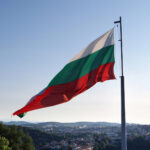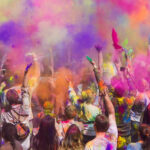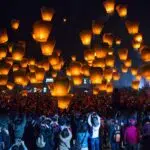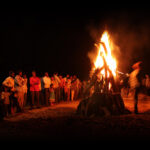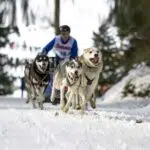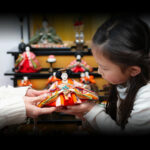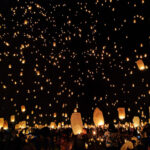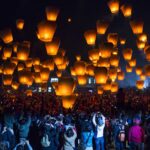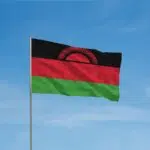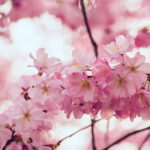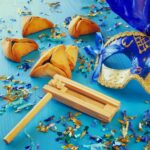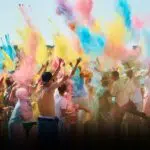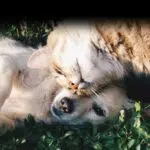Dolyatra is celebrated in March on varying dates each year, depending on the position of the moon, and this year, it falls on March 3. The holiday is similar to Holi and commemorates the last festival of the Bengali calendar. The holiday was created to observe the eternal bond and love between Lord Krishna and Radha. It immortalizes the day Lord Krishna expressed his love for his beloved Radha. The colorful powder called Phag is applied in the following order— first in respect to the pictures of the deceased family members, then it is put on the feet of elders as a mark of respect. Thereafter, the significant smearing fest of the powder on faces is begun.
History of Dolyatra
Dolyatra, also known as Doljatra, is a religious holiday celebrated when the last full moon in the Hindu Calendar is present. Although the holiday is similar to Holi, it is slightly different in procession and purpose.
Holi is celebrated to welcome spring and also mark the death of Holika, the evil sister of Hiranyakashyap, who attempted to kill his son Prahlad. Dolyatra, on the other hand, celebrates the love of Krishna and Radha.
Although Dolyatra also uses colored powder in their celebratory processions, the powder is used in a certain order in different ways to signify the purpose of the holiday. In addition to colored powder splashes, the idols of Lord Krishna and Radha are decorated and adorned. These statues are gracefully placed on decorated chariots and swung from one end to the other. Men are tasked with spraying colored powder at the idols, while women are encouraged to sing songs and bhajans.
The first day of Dolyatra is known as “Gondh”. This is the day people believe Lord Krishna visited Ghunucha. To note this, a bonfire is lit in front of the prayer house, and Lord Krishna’s idol is paraded as a custom. The idols of Krishna and Radha are taken around West Bengal with shouts of “Hari Bol” resounding in the air. The second day of the procession is called Bhor-Deul or Dol. On this day, the colored powder is applied to the photos of deceased family members. The colored powder is also put on the feet of elders to seek their blessings.
When the blessings of elders are satisfactorily received, the tradition of smearing other people with powdered colors begins. People also visit the houses of their near and dear ones with delicious Rasgullas. The third day is equally significant as people celebrate with more color. The parade continues on the fourth day (“Sueri”), with hundreds of people participating in prayer, worship, and more.
Dolyatra timeline
The primary reason for Dolyatra is born.
Lord Krishna's love interest is born.
Lord Krishna’s life on Earth ends and he passes away.
Dolyatra falls on the birthday of Chaitanya Mahaprabhu, a great saint.
Dolyatra FAQs
Are Dolyatra and Holi the same?
Dolyatra is commemorated on the same day as Holi — the last full moon in the Hindu calendar, and also has the title ‘Festival of Colours,’ which is similar to the Dolyatra celebration. Dolyatra differs from Holi as it is the last festival of the Bengali year and is based on a different legend.
What happens on the last day of Dolyatra?
It is called “Sueri” when Lord Krishna comes back from Ghunucha’s home. A large mass of people, including devotees and non-devotees, celebrate the end of this festival. People continue to throw colors on the idol as well as on each other.
How do I remove the colors after Dolyatra?
Simply take a bath soon after playing with phag, and soak or scrub to remove colors properly and avoid any kind of itchiness and skin problems. You could also encourage the use of organic colors to avoid chemical-based colors that might cause a problem.
How to Observe Dolyatra
Make and share dairy products
On Dolyatra, dairy products such as homemade butter, yogurt, cream, and prasad like panchamrit are prepared and distributed to everyone. Make your own dairy treat and share it with all that is near and dear to you.
Light a bonfire
The first day of Dolyatra is known as “Gondh.” Centuries ago, on this day, Lord Krishna visited Ghunucha (one of his wives). In honor of this, a bonfire is lit in front of the prayer house, and Lord Krishna’s idol is taken around it as a tradition.
Make “phag” (colored powder)
Make the colored powder known as phag, which is a key part of festivities. Using the phag starts with paying respects for dead loved ones as the powder is sprinkled on pictures of deceased family members, then on the idols and the feet of elders as a sign of respect. Finally, everyone gets to be covered in colored powder.
5 Fun Facts About Dolyatra
It is the last festival of Bengal
Dolyatra is the last festival of the Bengali Year.
The burning of ‘Agira’
The bonfire represents the burning of ‘Agira,’ who is responsible for various diseases.
Based on a love story
The custom of throwing colored powder is believed to emerge from the mythological love story of Radha and Krishna.
Radha was Lord Krishna's paramour
Lord Krishna was never married to Rahda but had a romantic attachment with her.
Radha was Krishna's wife previously
Radha was Lord Krishna's wife in his previous birth.
Why Dolyatra is Important
We get together with loved ones
What's better than coming together with friends and family and just mingling and having fun on a bright day full of leisure and joy? Dolyatra creates this cherished opportunity, and we want to enjoy every bit of it.
It is colorful
Dolyatra is full of color. From the phag of different shades to the beautiful make-up and clothes on that day, Dolyatra is simply colorful. So step into that colorful day and have some multicolored fun.
It is a day to celebrate love and happiness
Dolyatra is a day to love and feel the happiness that comes from it. The holiday celebrates the love of Lord Krishna and Radha, which symbolizes unity, loyalty, and trust.
Dolyatra dates
| Year | Date | Day |
|---|---|---|
| 2024 | March 25 | Monday |
| 2025 | March 14 | Friday |
| 2026 | March 3 | Tuesday |


